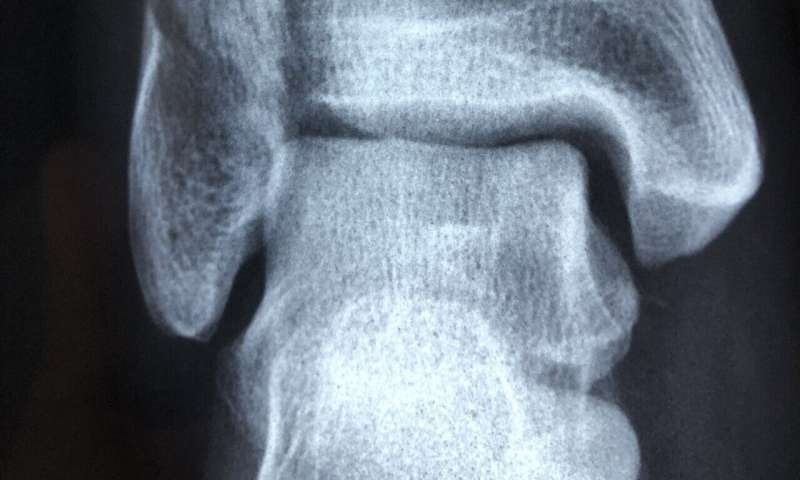by American College of Rheumatology

Credit: CC0 Public Domain
Researchers will present the first-ever study of fractures and calcium pyrophosphate deposition disease at ACR Convergence 2023, the American College of Rheumatology’s (ACR) annual meeting. They report a doubled risk of fractures in patients with acute calcium pyrophosphate crystal arthritis compared to those without the disease.
Calcium pyrophosphate deposition (CPPD) disease occurs when calcium pyrophosphate (CPP) crystals form near cartilage cells, and sometimes leads to joint inflammation, pain, and swelling. It has often been called pseudogout because of its clinical similarity to gout, yet far less is known about CPPD than about gout and other types of inflammatory arthritis.
Rheumatologist Sara Tedeschi, M.D., MPH, her colleagues at Brigham and Women’s Hospital in Boston, and collaborator from the Medical College of Wisconsin wanted to add to the knowledge base by investigating whether patients with CPPD disease are at an increased risk of fractures.
Previous studies had shown an association between low bone density and CPPD. Recent data from experimental models suggest that increased osteoclast (cells that degrade old bone) formation due to loss of function in osteoprotegerin (a protein that normally inhibits bone resorption) might contribute to disease pathogenesis.
To learn more, Tedeschi and her team performed a matched cohort study using electronic health record (EHR) data from the Mass General Brigham health care system. The study included more than 1,100 patients who had at least one episode of acute CPP crystal arthritis—the acute inflammatory form of CPPD —between 1991 and 2017. They were matched to more than 3,300 comparators who did not have acute CPP crystal arthritis though they could have other types of arthritis. The average age in both groups was 73, and more than half were women.
The index date for CPP crystal arthritis patients was either the first mention of pseudogout in their chart or the first synovial fluid analysis with a finding of CPP crystals. The period from EHR entry to index date was a minimum of 180 days. The index date for the matched comparators was a medical encounter within 30 days of the matched pseudogout patient’s index date.
The study’s primary outcome was the first fragility fracture (fractures resulting from a fall from standing height or lower) at the humerus, wrist, hip, or pelvis. Secondary outcomes were the first fracture at each of these anatomic sites. For patients with more than one fracture, only the earliest was used. Fragility fractures were identified using published algorithms with a positive predictive value greater than 90%.
The researchers estimated incidence rates and incidence ratios for any type of fracture and for fractures at each individual body site. They used Cox models (a statistical technique that can be used for time-to-event outcomes on one or more predictors) to estimate adjusted hazard ratios for fractures. Patients who had rheumatoid arthritis (RA) or were prescribed corticosteroids or osteoporosis treatment were excluded in sensitivity analyses in an attempt to eliminate the influence of these diagnoses/medications that are known to increase the risk of fracture.
The researchers found the fracture rate was twice as high in the acute crystal CPP arthritis cohort as in the comparator group after adjusting for traditional risk factors for fracture: 11.2 per 1,000 person years vs. 5.6 per 1,000 person years. The disparity between the two groups widened over time, and the sensitivity analyses produced comparable findings.
Tedeschi says the increased risk of fracture wasn’t particularly surprising, but that the magnitude of difference was. Also surprising, she says, was “that differences in the risk of fracture were seen, with similar magnitude, after excluding patients that had used corticosteroids in the 90 days before the index date. [Moreover], fracture rates diverged within the first months of follow-up, suggesting a pre-existing difference in bone health between cohorts.”
Tedeschi notes that the research doesn’t indicate if acute CPP crystal arthritis patients had repeat episodes or used corticosteroids after the index date, both of which might affect the findings. She adds that they could not assess falls, which would affect fracture risk and might have differed between CPPD and comparators. She concludes by stating, “The analysis did not assess vertebral fractures, as these can be asymptomatic and not captured by diagnosis codes.”
Still, the findings are clear: patients with acute CPP crystal arthritis have a doubled risk of fragility fractures.
“At a minimum, we hope that clinicians consider assessing bone mineral density in patients with CPPD to determine if osteoporosis treatment is needed,” Tedeschi says.
Provided by American College of Rheumatology

Leave a Reply